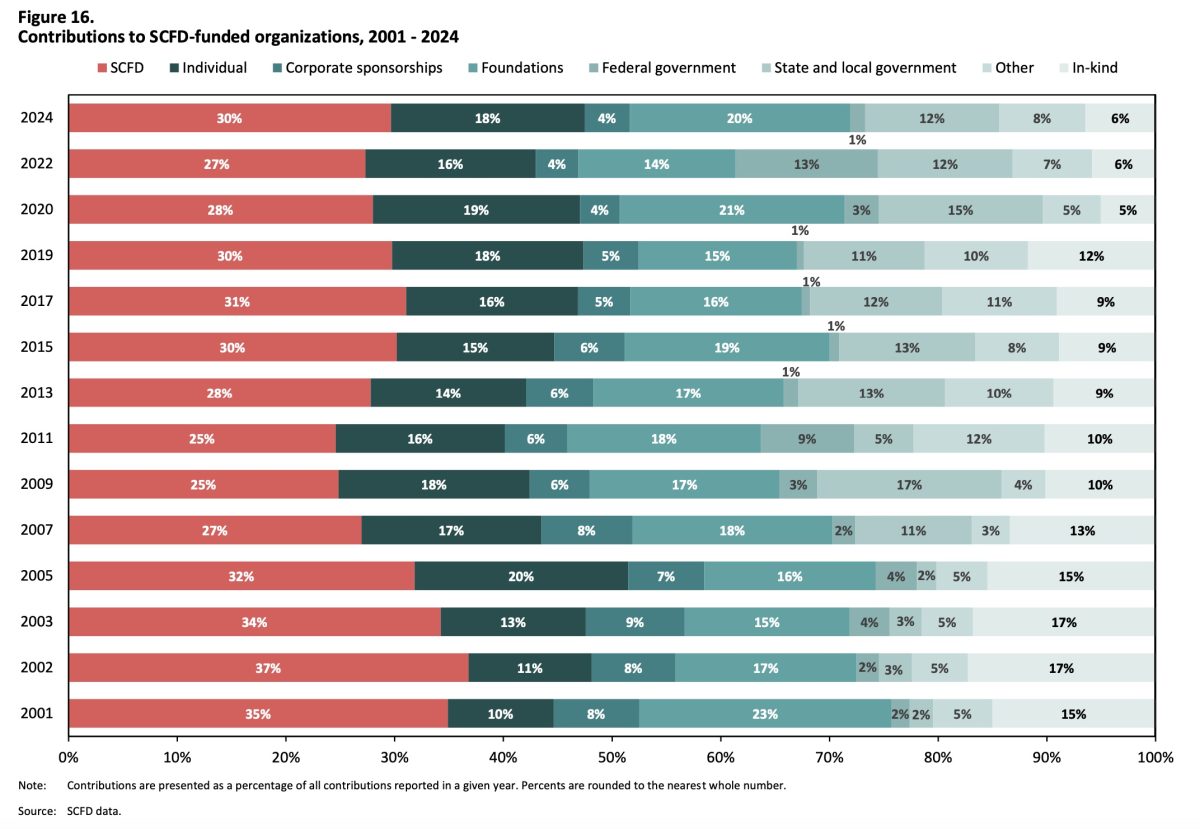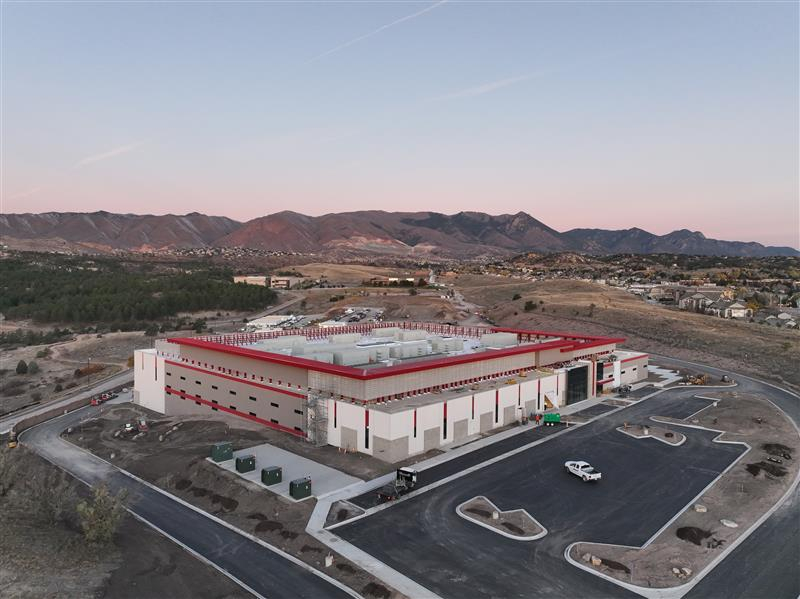Quick links: Affordable arts | Arts economic growth and losses | Fresca Foods gains majority investor | Colorado Springs new chipmaking plant | Take the reader poll | More Colorado economy news
For more than three decades, the Colorado Business Committee for the Arts has published an Economic Impact Study of Metro Denver Culture every other year, offering a deep dive into nearly 300 cultural organizations in Denver and its six surrounding counties.
The past two reports contained the same looming question: Have we bounced back to pre-pandemic levels?
In 2021 and 2023, the reports offered a pretty straightforward answer: Nope. But the 2025 report, released Thursday, is more of a mixed bag.
 Maggie Whittum as Titania/Hippolyta and Ratt Walsh as Bottom rehearse “A Midsummer Night’s Dream” Aug. 15, 2023, at Kilstrom Theater at the Denver Center for the Performing Arts. The play, featuring 17 actors, is produced by Phamaly Theatre Company, formed entirely of artists with disabilities. (Olivia Sun, The Colorado Sun via Report for America)
Maggie Whittum as Titania/Hippolyta and Ratt Walsh as Bottom rehearse “A Midsummer Night’s Dream” Aug. 15, 2023, at Kilstrom Theater at the Denver Center for the Performing Arts. The play, featuring 17 actors, is produced by Phamaly Theatre Company, formed entirely of artists with disabilities. (Olivia Sun, The Colorado Sun via Report for America)
For one, funding for the arts is all over the place, with pandemic-era relief funds expired or run dry, but individual donors are feeling more inspired than ever to give to their local arts organizations.
Jobs have bounced back and so has overall economic impact. Audience spending is exceeding its 2019 levels, even if attendance to in-person events is still down, at around 14.5 million in 2024.
In 2019 more than 15 million people went to concerts, ballets, plays and other performances in the seven-county metro area, which includes Adams, Arapahoe, Boulder, Broomfield, Denver, Douglas and Jefferson counties. (For reference, the combined attendance to home games of the Rockies, Broncos, Nuggets, Avalanche and Rapids in 2024 was just shy of 5 million.)
After plummeting in 2020, attendance shot back up to nearly 13 million by 2022 during a post-pandemic fervor that drove up demand for live events, and with it, skyrocketed ticket prices. The average ticket price for movies, theaters and concerts climbed more in the two years that venues were reopened after the pandemic — from 2021-23 — than they had in the five years leading up to it.
Setting aside the fact that Taylor Swift’s record-breaking “Era’s” tour began in early 2023, a cultural event that nearly created its own economy, the effect of “funflation,” as some economists were calling it, started to deflate by the end of summer 2023.
So while venues across the country have more recently reported attendance that meets or exceeds pre-pandemic rates, “recent research by Deloitte Consulting indicates that the return has been tempered by the rising costs of attending these events,” the CBCA report notes.
Making the arts more affordable
Some arts organizations are taking notice. The Museums for All Initiative, which offers free or deeply discounted admission to museums for those who receive help from the federal Supplemental Nutrition Assistance Program, counted 23 participating organizations in Colorado in 2024, compared with eight in 2019.
Earlier this year, the Arvada Center started offering $10 tickets to theater productions, and $6 tickets to youth theater programs for SNAP recipients.
 A scene from the second act of “Clybourne Park,” running until March 30, 2025, at the Arvada Center for Arts and Humanities. (Photo by Amanda Tipton Photography)
A scene from the second act of “Clybourne Park,” running until March 30, 2025, at the Arvada Center for Arts and Humanities. (Photo by Amanda Tipton Photography)
“It just seems like such a great way to be able to offer something really concrete, to provide a way around what can be a barrier to access for the arts, which is ticket price,” said Sarah Kolb, director of communications and marketing for the Arvada Center.
The Arvada Center tested the $10 ticket program on two theater productions and one youth program during their spring season, “and people really showed up,” Kolb said. A total of 169 people across the three shows took advantage of the discounted tickets.
So far they’ve sold 512 SNAP-discounted tickets to shows in the 2025-26 theater season, which started in September.
“I don’t want to make the assumption that those are people who would or wouldn’t have come to the show another way,” Kolb said. “But I think it’s really important that people know there’s a way they can do something meaningful with their kids, that they can introduce their kids to the arts, or can come enjoy a performance that will offer a moment of escapism.”
The Arvada Center is one of nearly 50 cultural centers that offer discounted admission to SNAP recipients around Colorado.
 Nationally, individual donations accounted for two-thirds of cultural sector donations, followed by foundation giving at nearly 20 percent. In Colorado, foundation giving mirrors that at the national level, though a much smaller portion comes from individual donors. (Courtesy of Colorado Business Committee for the Arts)
Nationally, individual donations accounted for two-thirds of cultural sector donations, followed by foundation giving at nearly 20 percent. In Colorado, foundation giving mirrors that at the national level, though a much smaller portion comes from individual donors. (Courtesy of Colorado Business Committee for the Arts)
Where the arts are seeing economic growth and loss
Despite ongoing ticketing woes — and general uncertainty about the economy — the overall economic impact of metro Denver’s cultural industry is higher than it was in 2019, according to the report.
“Results from the study indicate record-breaking levels of economic activity and impact of SCFD-funded organizations in the Metro Denver region in 2024,” the report states. SCFD, the Scientific and Cultural Facilities District, is a special tax district formed by the state legislature in 1988. All of the 285 organizations involved in the study, which range from tiny, volunteer-run orgs to institutions like the Denver Art Museum and Denver Center for the Performing Arts, are funded in some part by SCFD.
Economic activity as the report defines it is an aggregate measure related to the cultural sector that includes direct spending, like tickets, concessions and staff payrolls, and indirect spending, like child care, transportation and dinner before a show. That total was $3.1 billion in 2024, a nearly 20% increase from 2022, and a whopping 36% increase over 2019.
Meanwhile, jobs at cultural organizations showed year-over-year growth, hitting an all-time high of 14,466 total positions in the cultural sector.
Within those available roles, the number of part-time positions increased the most dramatically over two years between studies, although there were overall slightly fewer part-time positions than before the pandemic. Contracted and full-time positions have climbed steadily since 2019, both growing by about 12%, but contract positions make up the largest share of cultural jobs in metro Denver.
And where the money comes from to pay all those contract workers and keep the lights on has shifted dramatically over the past six years.
Since the last report came out in 2023, federal government funding for the arts dropped by 89%, mostly due to the loss of pandemic-era relief programs.
But arts organizations have always had close ties with private philanthropy, too. A 2023 study analyzed financial data for nearly 100,000 nonprofits and found that the arts in America are funded mostly through philanthropy and donations at all levels — from individual art lovers to major foundations.
 Madison Stout as Helena and Graham Bryant as Demetrius rehearse “A Midsummer Night’s Dream” Aug. 15, 2023, at Kilstrom Theater at the Denver Center for the Performing Arts. The play, featuring 17 actors, is produced by Phamaly Theatre Company, formed entirely of artists with disabilities. (Olivia Sun, The Colorado Sun via Report for America)
Madison Stout as Helena and Graham Bryant as Demetrius rehearse “A Midsummer Night’s Dream” Aug. 15, 2023, at Kilstrom Theater at the Denver Center for the Performing Arts. The play, featuring 17 actors, is produced by Phamaly Theatre Company, formed entirely of artists with disabilities. (Olivia Sun, The Colorado Sun via Report for America)
So while federal money took a nosedive between the 2023 and 2025 CBCA reports, individual and foundation giving increased by 10.7% and 36.4%, respectively. The data does not include 2025 giving, which saw a major and urgent boost after the federal government canceled grants from the National Endowment for the Arts and National Endowment for the Humanities, and wrote both out of the proposed federal budget.
“I think one of the interesting responses I’ve seen is that there is this disruption and concern about the impact of funding on a national level,” Kolb, from the Arvada Center, said. “And I think it’s making people realize why it’s important to really show up for the local arts communities and artists, and all the things that are right around us.”
Doubling down on granola
Fresca Foods is one of those Colorado success stories that launched in 1993 and is now a force in the natural foods industry. The company, which makes granola and other natural snacks, has grown to more than 450 employees, many who work at its manufacturing plant and warehouse spaces in Louisville and Aurora, respectively.
As of Tuesday, it’s now majority owned by Cerealto, a food manufacturer based in Spain.
If you’ve never heard of Fresca (no, not the citrus soda brand owned by Coca-Cola Company), the company will probably forgive you.
 Recognize these healthy-looking cookies? Fresca Foods in Louisville makes them for other consumer brands. But the company won’t say which ones. (Handout)
Recognize these healthy-looking cookies? Fresca Foods in Louisville makes them for other consumer brands. But the company won’t say which ones. (Handout)
They don’t have their own consumer brand on store shelves. But they make organic and natural food snacks for “some of the world’s largest food companies as well as established and growing entrepreneurial brands,” CEO Brandon Viar said in an email. Contracts don’t let them share who those brands are.
The investment of an undisclosed amount gets Cerealto’s foot into the American market. Fresca’s own foot brought in about $111 million in annual revenues and will make up 20% of Cerealto’s sales. But this wasn’t about bringing Ceralto’s food to the U.S. It’s about Fresca.
 Brandon Viar, CEO of Fresca Foods in Louisville. (Handout)
Brandon Viar, CEO of Fresca Foods in Louisville. (Handout)
“Over the coming months, Fresca and Cerealto will collaborate on a joint growth plan that includes investing in new capacity, expanding in high-growth snacking categories, strengthening Fresca’s U.S. footprint, and developing new opportunities with customers,” Viar said. “The goal is to build a stronger, more international business for the long term.”
The healthy snacks market is no small organic potato. One market-research firm sized it at $31.9 billion last year and likely to reach $54.61 billion by 2033. And a longtime hub for organic food startups happens to be right in Boulder, the birthplace of brands like Justin’s, Bhakti Chai and Horizon Organic.
While some of those big-name brands have new corporate owners, it’s still a treat for the local industry, according to Naturally Colorado, a nonprofit organization that focuses on nurturing “conscious growth.”
“It’s a testament to the collaborative spirit and entrepreneurial energy that have made Colorado a hub for conscious food and beverage businesses,” Executive Director Kristine Carey said in an email. “Fresca Foods has long been part of Colorado’s vibrant natural and organic products ecosystem. … Investments like this highlight the strength and maturity of our state’s natural products industry and the national and global attention it continues to attract.”
Sun economy stories you may have missed
 Tesla electric vehicles are charged at a charging station in State College, Pa., Monday, Aug. 25, 2025. (AP Photo/Gene J. Puskar)
Tesla electric vehicles are charged at a charging station in State College, Pa., Monday, Aug. 25, 2025. (AP Photo/Gene J. Puskar)
➔ How much business did Tesla lose in Colorado from Elon Musk’s hard right turn? A lot, Yale researchers say, in Colorado and across the country, perhaps more than 1 million car sales. >> Read story
➔ Budget pain hits local governments in Colorado as costs rise, funding shrinks and the federal shutdown drags on. Local governments across Colorado face budget deficits in 2026. Some are tapping their reserves to keep people fed as SNAP benefits lapse. >> Read story
➔ How Medicaid cuts will hurt Colorado families caring for adult children with disabilities. Parents caring for adult children with severe developmental disabilities want to know why their pay is being cut when they are saving taxpayers tens of thousands of dollars per year. >> Read story
➔ Colorado job hunters are using AI. So are employers, scammers and even the state’s labor department. The job market in Colorado and around the country is pitting AI generators against AI filters and leaving real workers and hiring managers feeling trapped in the middle. >> Read story
➔ Ethics complaints filed against Democratic state lawmakers who attended Vail retreat with lobbyists. The complaints were filed by Colorado Common Cause, a liberal-leaning nonprofit that advocates for an open government. >> Read story
➔ UCHealth will directly receive taxpayer dollars in Estes Park merger. The health system will take over Estes Park Health and receive tax revenue via the Park Hospital District. >> Read story
Take the poll: Thanksgiving plans?
With the federal government shutdown, tracking inflation and the cost of the Thanksgiving meal will be challenging this year. Can you help? Help us better understand how Coloradans are impacted by taking the What’s Working reader poll. Thanks in advance!
Take the poll >> cosun.co/WWthanks2025
Other working bits
➔ Another 150 federal workers file for unemployment this week. Colorado Department of Labor and Employment’s fed-worker daily unemployment tracker is now weekly. And so far this week, about 157 federal workers filed a first-time unemployment claim as of Nov. 5. Claims from federal workers since the government shutdown on Oct. 1 was 2,100 as of Wednesday.
Statewide, fed-worker filings made up 14.3% of all first-time unemployment claims, which grew to 14,661 in October. Those on continued unemployment benefits also grew to 33,160 in the last week of the month, up 3.7% from the week earlier, according to the state labor department.
➔ Chipmaker opens new Colorado Springs manufacturing plant. Nearly three years in the making, Entegris’ new 135,000-square-foot manufacturing plant opened Wednesday. Entegris earlier committed to investing $600 million into building a new plant and hiring 500 new workers. As of this week, about 100 people are working on site, but this is just phase one, according to a spokesperson.
 The new Entegris manufacturing plant in Colorado Springs. (Handout)
The new Entegris manufacturing plant in Colorado Springs. (Handout)
The Massachusetts-based company makes semiconductor materials for clients like Intel and Samsung. Fittingly, it chose land that was once home to Hewlett Packard’s old computer disk drives factory. While Entegris already had operations in Colorado Springs, an added incentive was the Biden administration’s CHIPS and Science Act of 2022, which set aside $280 billion in taxpayer money to subsidize the return of semiconductor manufacturing to America. Entegris was granted up to $77 million last year.
At the new plant, workers will make Front-Opening-Unified Pods, or FOUPs, which “are essential for chip purity and yield,” the company said. The plant also marks “the return of Entegris’ FOUP manufacturing to the U.S. for the first time in decades.”
➔ Denver Labor’s enforcement of wage-theft laws nets $2.3 million for workers. One of Denver’s higher profile public advocates of ordinary workers happens to be inside the city auditor’s office. The auditor’s labor investigators recovered $2.3 million in restitution for 7,200 workers in the city whose employers paid them less than minimum wage, violated sick-leave pay rules or made illegal pay deductions (see the cases). The amount and impacted workers were at record levels.
Part of Denver Labor’s role is also to keep businesses up to date with the law changes, which companies may overlook, like the annual minimum wage increase for all businesses that operate in city limits. Heads up: Denver’s current minimum wage of $18.81 jumps to $19.29 on Jan. 1. >> Submit a wage complaint
Got some economic news or business bits Coloradans should know? Tell us: cosun.co/heyww
Thanks for sticking with me for this week’s report. As always, share your 2 cents on how the economy is keeping you down or helping you up at cosun.co/heyww. ~ tamara
Miss a column? Catch up:
What’s Working is a Colorado Sun column about surviving in today’s economy. Email tamara@coloradosun.com with stories, tips or questions. Read the archive, ask a question at cosun.co/heyww and don’t miss the next one by signing up at coloradosun.com/getww.
Support this free newsletter and become a Colorado Sun member: coloradosun.com/join
Corrections & Clarifications
Notice something wrong? The Colorado Sun has an ethical responsibility to fix all factual errors. Request a correction by emailing corrections@coloradosun.com.
Type of Story: News
Based on facts, either observed and verified directly by the reporter, or reported and verified from knowledgeable sources.






